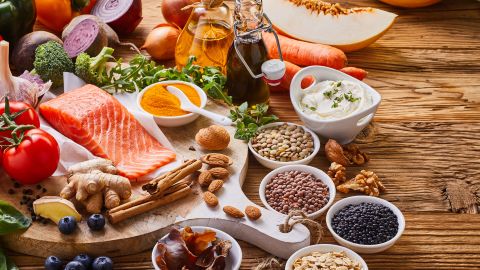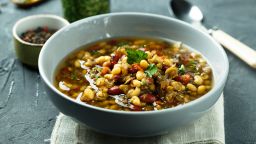Sign up for CNN’s Eat, But Better: Mediterranean Style. Our eight-part guide shows you a delicious expert-backed eating lifestyle that will boost your health for life.
About 85% of girls suffer painful bloating, cramps and abdominal pain during their monthly periods — and for some the problems can last for years.
“Since menstrual pain is a leading cause of school absenteeism for adolescent girls, it’s important to explore options that can minimize the pain,” said Dr. Stephanie Faubion, director of the Mayo Clinic’s Center for Women’s Health in Jacksonville, Florida, in a statement. She was not involved in the study.
But there are behavioral adjustments girls and young women can make to reduce pain, according to a new analysis of studies. “Diet modification could be a relatively simple solution that could provide substantial relief for them,” said Faubion, who is also the medical director for The North American Menopausal Society, of the research findings.
The abstract, presented Wednesday at the annual meeting of NAMS, explored the connection between diet and dysmenorrhea, the medical term for painful periods. The lead author, Serah Sannoh, told CNN she became interested in the topic due to her own menstrual pain, which has plagued her since adolescence.
“I found diets high in inflammatory foods such as animal meats, oil, sugars, salts, and coffee contribute to an increased risk of pain during a woman’s period,” said Sannoh, who conducted the research as an intern at Rutgers University’s Robert Wood Johnson Medical School in New Jersey. She is currently a medical student at Temple University’s Lewis Katz School of Medicine in Philadelphia.
“A lot of the things that young people like to eat are are highly inflammatory … lunch meats, foods full of sugars and trans fats. But if you go on an anti-inflammatory diet — fruit, vegetables, olive oil, like the Mediterranean diet — you’ll get less cramping,” said NAMS board member Dr. Monica Christmas, an associate professor of obstetrics and gynecology at the University of Chicago, who was not involved in the study.
The scientific evidence has shown eating a healthy diet, getting good sleep and exercising are effective measures in curtailing the duration and severity of cramps, Christmas said. But she noted it’s important women see a health care provider: “Make sure that there’s not some other medical condition that might also be contributing to the symptoms.”
As your body prepares to menstruate, endometrial cells that built a lining in the uterus to welcome a fertilized egg begin to break down. As they do, those cells release large amounts of fatty acids called prostaglandins to make the uterine layer contract and expel the unused tissue. The body also releases prostaglandins naturally during labor to open the cervix for birth.
What causes the pain?

Prostaglandins act like hormones, causing blood vessels and smooth muscles to constrict, resulting in cramping and pain. Researchers have found prostaglandin levels are higher and uterine contractions are stronger and more frequent in women with menstrual pain than women who have little or no pain, according to American Association of Family Physicians.
Eating inflammatory foods only adds to the discomfort, studies have found. Highly processed and high-sugar foods and fatty, greasy foods are common culprits — a 2018 study found college students who ate more snacks had more pain during their periods.
Another 2018 study of Spanish college students found women who drank cola and ate meat were more likely to suffer pain during their cycle than women who ate more vegetables and fruits. In fact, a 2020 study found women who ate fewer than two servings of fruit a day were more likely to suffer pain during their menstrual cycle.
Part of the problem is an imbalance between omega-3 and omega-6 fatty acids, Sannoh found. Omega-3 fatty acids — found in foods such as salmon, tuna, sardines, oysters, walnuts, chia and flaxseeds — are anti-inflammatory. Studies have linked them to a reduction in risk for many chronic diseases triggered by inflammation.
Omega-6 fatty acids keep skin, hair and bones healthy and help regulate metabolism, in addition to their role in the reproductive system. But too many of these fatty acids can cause inflammation when the body ultimately breaks them down into arachidonic acid, which lowers the body’s pain threshold.
“From my research, I found out that people with diets high in omega-6 fatty acids, especifically those derived from animal-based products, have a higher presence of arachidonic acid in the body, which increases the amount of pro-inflammatory prostaglandins that help the uterus contract,” Sannoh said.
“When you have a diet that balances omega-3 and omega-6 fatty acids, and you decrease the amount of inflammatory foods that you ingest, that will decrease the painful menstrual experience,” she added.
Two separate studies from 2011 and 2012 revealed women who took omega-3 fatty acid supplements reduced the intensity of menstrual discomfort enough to lower their use of ibuprofen for pain relief. And a 1996 study found a highly significant relationship between omega-3 fatty acids and milder menstrual symptoms in teens.
Other solutions
Changing your diet is not the only way to fight menstrual pain. Nonsteroidal anti-inflammatory drugs, or NSAIDs, reduce the production of prostaglandins, which is why they are a mainstay of treatment for cramps, Christmas said.
However, these pain medications also have side effects. According to a 2015 Cochrane Library review of evidence, NSAIDs are linked to bloating, diarrhea, dizziness, indigestion, headaches, heartburn, high blood pressure, nausea, vomiting and on rare occasions, raised liver enzymes.
Certain oral birth control pills also lower the production of prostaglandins in the uterine lining, which then reduces both blood flow and cramping. Doses of less than 35 micrograms were “effective and should be the preparation of choice,” according to a 2009 Cochrane Library review.
But if you are not interested in using these methods — or want extra relief — give an anti-inflammatory diet a try. Sannoh put her research into practice by decreasing her intake of red meat and other inflammatory foods such as sugar and coffee, and told CNN that it did decrease her menstrual pain.
There’s an added benefit to adopting an anti-inflammatory lifestyle, Christmas said.
“These diets are also associated with less high blood pressure, less cardiovascular disease, less diabetes, less arthritic issues, decreased morbidity and mortality, especially after menopause,” Christmas said.
“So if you can get people who are young to eat better, exercise, and live a healthier lifestyle, they’re going fare better as they age.”
"here" - Google News
October 12, 2022 at 11:07AM
https://ift.tt/34lc1JY
Fight menstrual cramps with food. Here's how - CNN
"here" - Google News
https://ift.tt/runQ0gM
https://ift.tt/N50e8BH




No comments:
Post a Comment